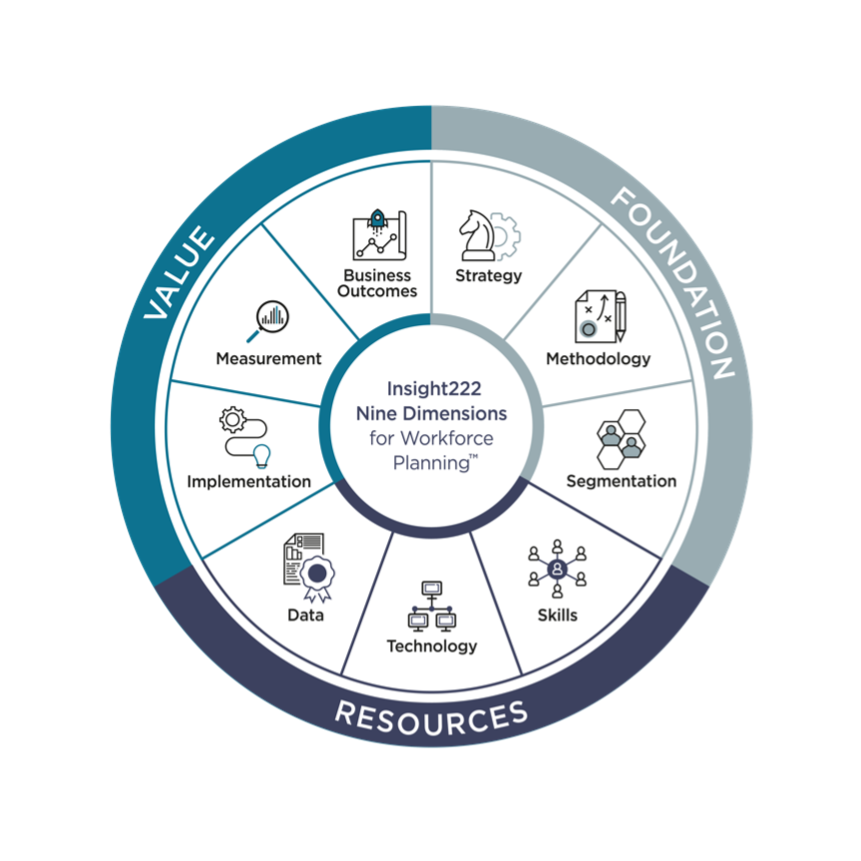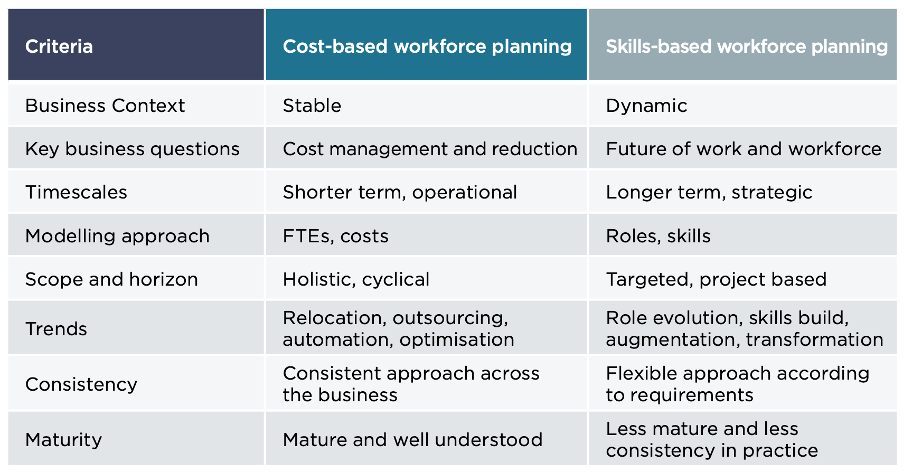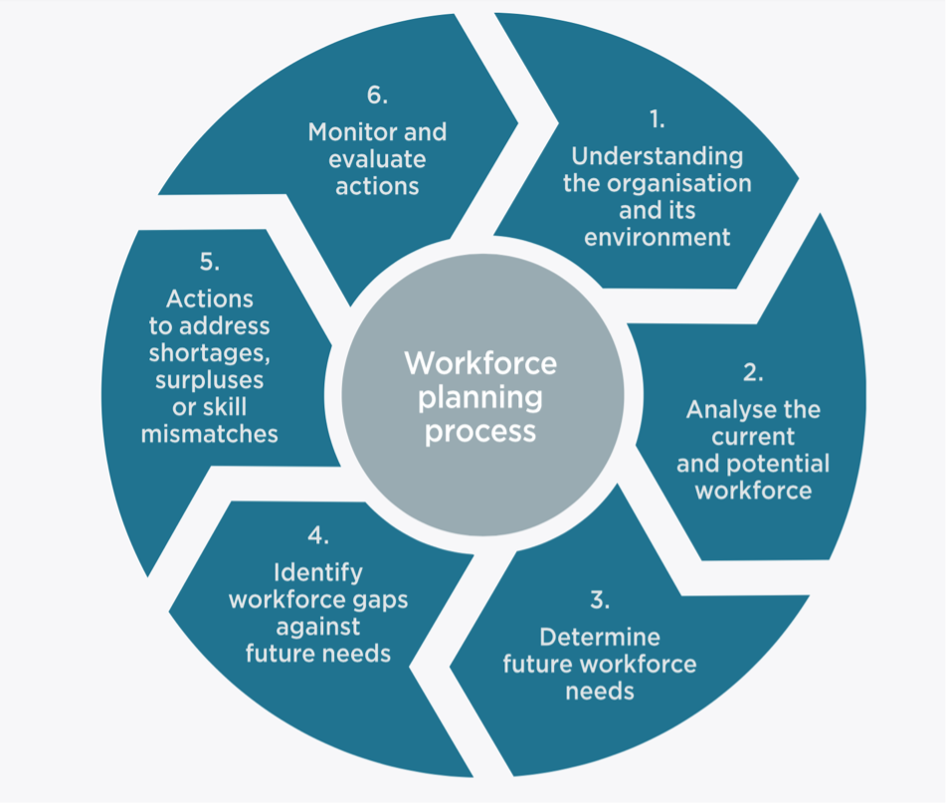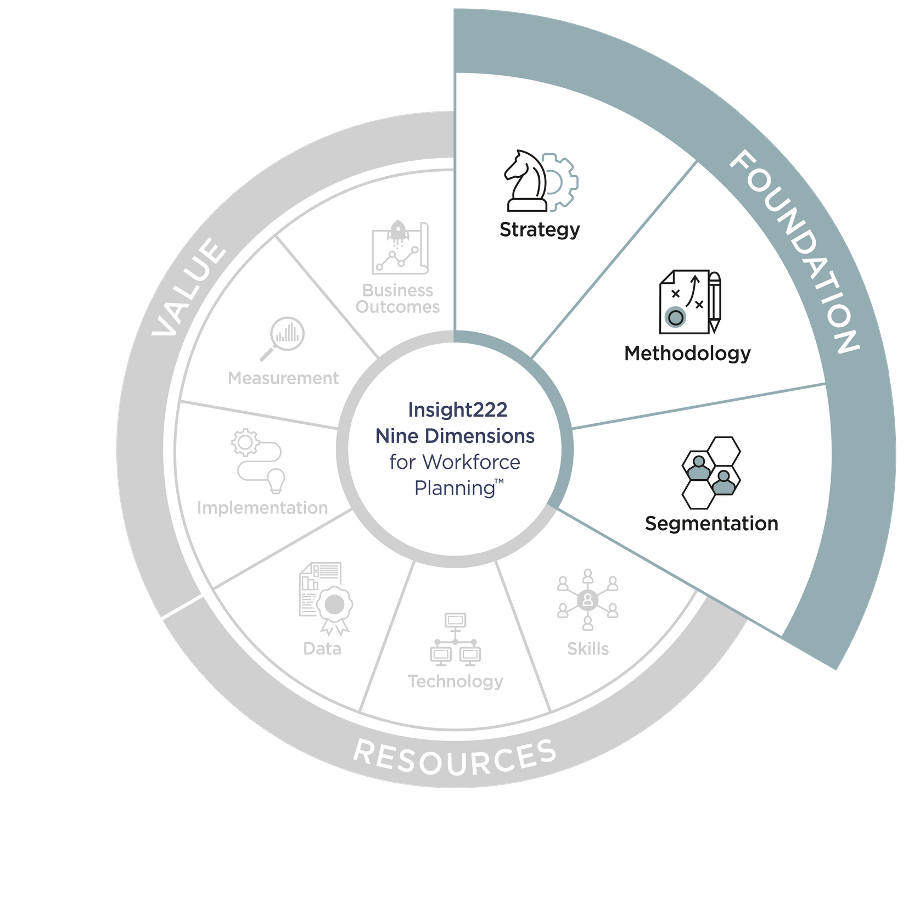Building an Effective Skill-Based Workforce Planning Capability
As a result of research conducted by Insight222 in 2020, investigating the future of workforce planning, we have developed a new model called the Insight222 Nine Dimensions for Workforce Planning™
The Insight222 Nine Dimensions for Workforce Planning™ is derived from qualitative and quantitative research across over 70 global organisations and decades of combined experience in the areas of people analytics, workforce planning and talent management.
In this article, we’re going to discuss:
The surging interest in a skills-based approach to workforce planning
How the Insight222 model expands on the traditional, well-known model of workforce planning
The Nine Dimensions in detail
The surging interest in a skills-based approach to workforce planning
A skills-based approach to workforce planning is becoming increasingly attractive to organisations. Skill availability is well and truly on the CEO’s agenda, with research from McKinsey showing that 79% of CEO’s are concerned about skill availability impacting innovation, cost, quality and growth.
Skills have taken centre stage especially since the impact of automation and augmentation on job roles has been more keenly felt. As work is divided between workers and machines, entire roles will disappear. Instead, certain repetitive or routine tasks will become automated such as Robotic Process Automation (RPA), for example, which can perform repetitive analyses as much as 15 times faster than humans with almost no errors. Tasks that require workers to perform them, however, are variable, i.e., unpredictable, changing and requiring adaptive criteria. These tasks will become more sophisticated and require individuals to be more highly skilled.
Trends such as augmentation and automation require organisations to rethink their approach to understanding and developing talent, including how they engage in workforce planning.
In our own research at Insight222 on the future of workforce planning, nearly all companies surveyed - 90% - expressed a desire to build a skills-based workforce planning process. However, only a quarter of companies – just 26% - were actively doing so.
But before organisations rush to adopt a skills-based approach, careful consideration must be paid to the business question that is being addressed with workforce planning. As you can see in the table, organisations operating in a stable business environment, and business questions focused on cost management and reduction, for example, are still best answered with cost-based workforce planning. Ultimately, the right approach depends on the business challenge.
That is why, when we developed the Insight222 Nine Dimensions for Workforce Planning™, we were keen to showcase how the basic methodological principles of workforce planning remain the same, whether
adopting a skills-based or cost-based approach. These basic methodological principles, covered in the “Methodology” dimension, are vital for any workforce planning team to understand, regardless of approach.
Interested in learning more about Strategic Workforce Planning? Take a look at our online HR training courses on myHRfuture
Dimensions in the “resources” section of our model – namely “Technology” and “Data” are where organisations can tailor their workforce planning approach depending on the business question, by tailoring the platforms and solutions adopted and the data sources leveraged.
How the Insight222 model expands on the traditional, well-known model of workforce planning
Before we explore the Insight222 Nine Dimensions for Workforce Planning™ in more detail, let’s take a look at the traditional workforce planning process that many HR professionals are familiar with, and depend upon.
Traditional models like these are used for good reason, as they cover the basic elements of workforce planning effectively. Our intention with the Insight222 Nine Dimensions for Workforce Planning™ model is to take a broader perspective.
For example, in our model “Methodology” is one of nine dimensions. While in the traditional model, it is covered in three stages, which makes up 50% of the model. Methodology is a fundamental dimension of workforce planning, but without tackling the eight other dimensions, workforce planning will likely deliver sub-optimal value for the organisation. As discussed above, only by understanding the resources needed – skills, data and technology – can organisations tailor their workforce planning process effectively to the business challenge they are trying to solve.
The second crucially important development with the Insight222 model is an increased focus on organisational Strategy, Segmentation and Business Outcomes. The starting point for any workforce planning process is to understand and translate the business strategy into a workforce strategy that supports business goals.
The Nine Dimensions in detail
Let’s take a look now at three quick takeaways from the Nine Dimensions.
FOUNDATION | Strategy, Methodology & Segmentation
There is no “one size fits all approach” to workforce planning and teams should look to adapt their approach based on business strategy and goals.
The basic methodological principles can be applied to all types of workforce planning. Understanding the business strategy and its relationship to workforce strategy will determine which approach to take.
By segmenting the workforce, each segment can be treated independently. Workforce segments should be prioritised on two dimensions, impact on business value and difficulty of replacement.
RESOURCES | Skills, Technology & Data
The HR competencies required for effective workforce planning are consulting and influencing skills, analytical skills and stakeholder management.
There are three categories of workforce planning technologies: workforce planning and organisational design, talent market analytics, and talent management/skills inference.
A skills-based view can help business leaders to navigate the increasingly agile, dispersed, global workforce, as well as the rise of automation.
VALUE | Implementation, Measurement & Business Outcomes
Start workforce planning with a pilot project to limit risk, build relationships with key stakeholders, and enable agile experimentation.
Develop a four-step approach to implementation: develop workforce projects; create a workforce strategy; translate the strategy into workforce plans; and use scenario planning.
Actual workforce should be tracked against the plan, and the difference between the two should be investigated in terms of the plan design and implementation, and business impact.
Measuring the impact of workforce plans against tangible business outcomes is the best way to successfully foster buy-in and investment in workforce planning for the long term.
While we’ve summarised some of our key takeaways, download a detailed overview of the Nine Dimensions of Workforce Planning to learn more about how you can accelerate your business strategy by providing recommendations based on fact, insight and deep knowledge of the workforce across the markets in which you operate.
Final thoughts
While our research concluded that there is “no one-size fits all” approach to workforce planning, we did uncover that each one of our leading companies did several of these Nine Dimensions to a superlative level.
In summary, while the old saying of workforce planning still exists to some extent – “the right people, in the right place, at the right time and at the right cost” - it is much more than that in the competitive world of the 2020s.
Workforce planning done well will accelerate your business strategy by providing recommendations based on fact, insight and deep knowledge of the workforce across the markets in which you operate. Do it poorly and you may as well put the workforce plan in the bottom drawer.
The choice is yours. But discerning business and HR executives will be wise to understand how the Nine Dimensions for Workforce PlanningTM outlined here can deliver value and accelerate your business strategy and competitive edge.
ABOUT THE AUTHOR
Ian Bailie is the Managing Director of myHRfuture.com and an advisor and consultant for start-ups focused on HR technology and People Analytics, including Adepto, Worklytics and CognitionX. In his previous role as the Senior Director of People Planning, Analytics and Tools at Cisco Systems, he was responsible for delivering the tools and insights to enable and transform the planning, attraction and management of talent across the organisation globally. Ian is passionate about HR technology and analytics and how to use both to transform the employee experience and prepare companies for the Future of Work.
Build the HR Skills of the Future you need to Press PLAY on Your Career®
If you’re looking to get started in workforce planning or build the HR skills of the future, checkout the myHRfuture academy and our online HR training courses. Our content helps HR practitioners to become more knowledgeable in People Analytics, Digital HR and Workforce Planning. myHRfuture helps you build a foundation and really deepen your expertise in the skills you need to advance your career. The myHRfuture Academy provides you with an on-demand platform where you can get access to over 600+ pieces of short, bitesized learning content all expertly curated to help you build knowledge in the skills that you need to prepare for the future of HR. Get access to exclusive content on People Analytics, Digital HR & HR Technology, Design Thinking, Workforce Planning, Consulting & Influencing and Stakeholder Management. So what are you waiting for invest in your career and learn the HR skills of the future.








